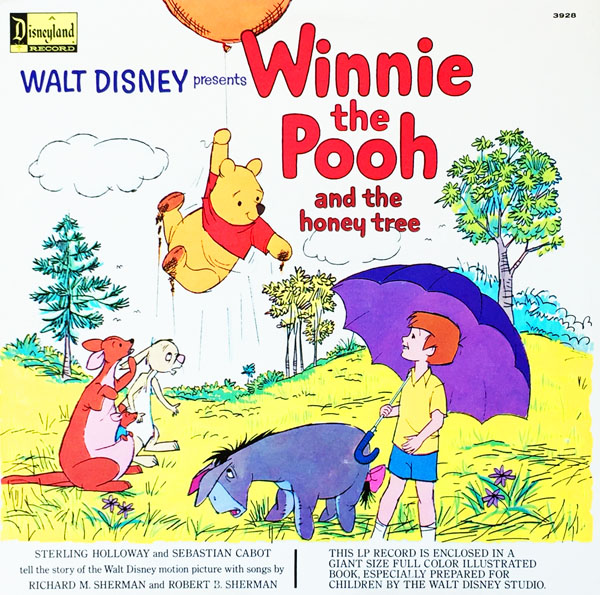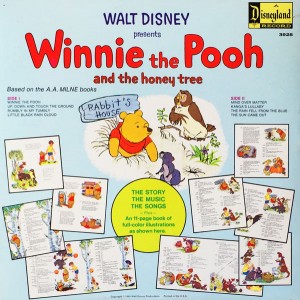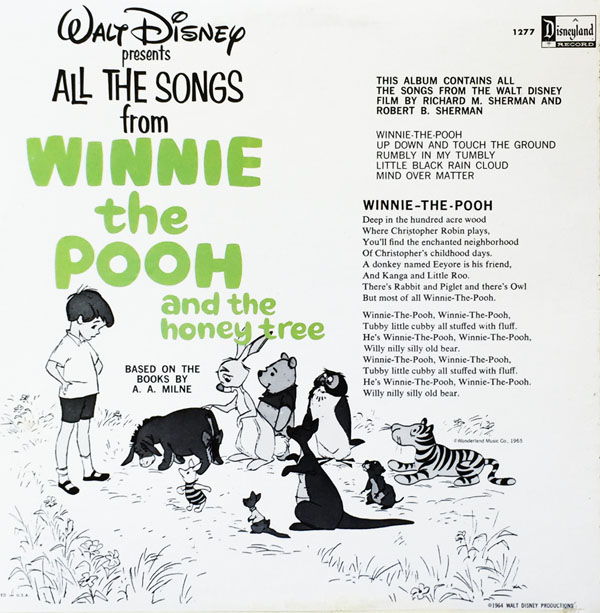The first installment of Walt Disney’s Pooh short trilogy was released 50 years ago, so let’s take a Spin with Pooh and his friends on his first Disneyland vinyl releases.

WALT DISNEY’S STORY OF WINNIE THE POOH AND THE HONEY TREE
Disneyland Records ST-3928 (12” 33 1/3 RPM LP with Book)
Released in May, 1965. Executive Producer: Jimmy Johnson. Producer/Arranger/Conductor: Camarata. Running Time: 29 minutes.
Voices: Sterling Holloway (Pooh); Sebastian Cabot (Narrator); Junius Matthews (Rabbit); Howard Morris (Gopher); Hal Smith (Owl); John Fiedler (Piglet); Bruce Reitherman (Christopher Robin); Barbara Luddy (Kanga); Clint Howard (Roo); Ralph Wright (Eeyore); Jimmy Macdonald, Ginny Tyler, Dal McKennon (Bees); B.J. Baker (Soloist); The Jack Halloran Singers.

ALL THE SONGS FROM WALT DISNEY’S WINNIE THE POOH AND THE HONEY TREE
Disneyland Records DQ-1277 (12” 33 1/3 RPM LP)
Released in May, 1965. Executive Producer: Jimmy Johnson. Producer/Arranger/Conductor: Camarata. Harpsichordist: Amindav Aloni. Running Time: 16 minutes.
Voices: Sterling Holloway (Pooh); B.J. Baker (Soloist); The Jack Halloran Singers.
Songs: “Winnie the Pooh,” “Up Down and Touch the Ground,” “Rumbly in My Tumbly,” “Little Black Rain Cloud,” “Mind Over Matter,” “Kanga’s Lullaby,” “The Rain Fell From the Blue,” “The Sun Came Out” by Richard M. Sherman and Robert B. Sherman.
The stories and rhymes of A. A. Milne were already beloved jewels of children’s literature before Walt Disney adapted selected tales for short animated films. Even if the first films had only been moderate successes–which turned out not to be the case, as they launched a huge Disney franchise–Pooh records on the Disneyland label stood a good chance of being steady sellers for generations.
 Surely for that reason, and Disney’s common practice of releasing publications and other merchandise well in advance of the film release dates, Disneyland Records released a full line of LP’s, 45’s and a 7” read along record and book set many months before Winnie the Pooh and the Honey Tree premiered in theaters on a double bill with The Ugly Dachshund on February 4, 1966.
Surely for that reason, and Disney’s common practice of releasing publications and other merchandise well in advance of the film release dates, Disneyland Records released a full line of LP’s, 45’s and a 7” read along record and book set many months before Winnie the Pooh and the Honey Tree premiered in theaters on a double bill with The Ugly Dachshund on February 4, 1966.
With the animated film still in production, it is likely that Buddy Baker’s score was not completed in time to use it on records, so the vinyl versions do not feature music from the soundtrack (though you can hear a tiny bit of piano in Holloway’s first line of dialogue).
Instead, Tutti Camarata conducted a small orchestra for the records that featured a harpsichord, creating a fresh, bouncy sound that was perfect for Pooh. Used to great success in such ’50s hits as Rosemary Clooney’s version of Ross Bagdasarian’s “Come On-A My House,” the harpsichord became a staple of modestly budgeted Disney records of the’60s, including 10 Songs from Mary Poppins with Marni Nixon, Stories of Hans Christian Andersen with Robie Lester and The Scarecrow of Oz with Ray Bolger.
 The most prominent vocalist in the Honey Tree choral songs is Hollywood studio singer B.J. Baker, who can be heard singing for Nancy Kwan in Rodgers and Hammerstein’s Flower Drum Song, among other films. As a member of the Randy Van Horne Singers, she also sang on many a classic Hanna-Barbera theme.
The most prominent vocalist in the Honey Tree choral songs is Hollywood studio singer B.J. Baker, who can be heard singing for Nancy Kwan in Rodgers and Hammerstein’s Flower Drum Song, among other films. As a member of the Randy Van Horne Singers, she also sang on many a classic Hanna-Barbera theme.
For the Winnie the Pooh and the Honey Tree Storyteller LP, Sebastian Cabot provided narration especially for the album. The text of the book follows along with the record, which was rare in Storyteller albums of the ’50s and ’60s). All the other dialogue comes from the soundtrack. This is a stellar voice cast that includes a rare Disney appearance by Howard Morris as Gopher (who isn’t in the book and says so—a very clever “in”-joke) as well as Disney story artist Ralph Wright, Barbara Luddy, Junius Matthews, Hal Smith, and pre-Jungle Book actors Bruce Reitherman and Clint Howard as Christopher Robin and Roo, respectively.
The artwork on both the Storyteller and the song album is very sketchy and unusually rough for most Disney records, perhaps because the projects were assembled in a hurry with whatever materials were available. In his autobiography, Inside the Whimsy-Works, Jimmy Johnson recalls an amusing story in which Louis Prima visited the Disneyland Records office with his young daughter, who was a fan of Pooh and company. When Johnson gave Miss Prima the song album as a gift, the child noticed that Tigger was pictured on the back cover, even though he wasn’t in the movie. Johnson assured her that Tigger would appear in the next film. (The Tigger on the cover is also more in the style of Ernest Shepherd’s book illustrations than the Disney design introduced in 1968’s Winnie the Pooh and the Blustery Day.)

 There is more story and song material on the records than what ended up in the final film, including the “Wherever I am, there’s always Pooh” verse. The sequence in which Pooh becomes stuck in Rabbit’s doorway includes additional Sherman Brothers variations of “Mind Over Matter,” in which Pooh soaks up rain and expands, then shrinks after drying. This is all conveyed through music and has no supportive dialogue, so it’s difficult to know whether it was planned for the film or created for the record to lengthen the playing time (the song record in particular is one of Disney’s shortest LP’s, running only 16 minutes despite every attempt to stretch it to album length with instrumental bridges and two reprises of Pooh’s song).
There is more story and song material on the records than what ended up in the final film, including the “Wherever I am, there’s always Pooh” verse. The sequence in which Pooh becomes stuck in Rabbit’s doorway includes additional Sherman Brothers variations of “Mind Over Matter,” in which Pooh soaks up rain and expands, then shrinks after drying. This is all conveyed through music and has no supportive dialogue, so it’s difficult to know whether it was planned for the film or created for the record to lengthen the playing time (the song record in particular is one of Disney’s shortest LP’s, running only 16 minutes despite every attempt to stretch it to album length with instrumental bridges and two reprises of Pooh’s song).
Surprisingly, genuine Pooh film soundtrack material is scarce on Disney recordings to this day. The theme appeared on the 1990 CD, The Disney Collection Volume One, but for the most part, every time a Pooh song pops up on a Disney music compilation, it’s usually a very accurate sound-alike with the voice of Jim Cummings instead of Sterling Holloway.
GIVE A LITTLE LISTEN
“Winnie the Pooh”
Like Sam Edwards’ “The Wonderful Thing About Tiggers,” this rendition of the title song is the one that kids in the ‘60s and ‘70s grew up with. It was even included on Buena Vista’s tribute compilation album, The Music of Walt Disney.


 GREG EHRBAR is a freelance writer/producer for television, advertising, books, theme parks and stage. Greg has worked on content for such studios as Disney, Warner and Universal, with some of Hollywood’s biggest stars. His numerous books include Mouse Tracks: The Story of Walt Disney Records (with Tim Hollis). Visit
GREG EHRBAR is a freelance writer/producer for television, advertising, books, theme parks and stage. Greg has worked on content for such studios as Disney, Warner and Universal, with some of Hollywood’s biggest stars. His numerous books include Mouse Tracks: The Story of Walt Disney Records (with Tim Hollis). Visit 






















































What a fun post today, Greg!
I’ve always loved the songs from the Pooh films. As a child, I made my own soundtrack tape by holding a Playskool Tape Recorder & Microphone up to the speaker on the television set.
It was great to hear the extra bits of “Mind Over Matter” from today’s spin! (And… I learned a fun bit of trivia about Ross Bagdasarian… I didn’t know he wrote “Come On-A My House”…)
JP, did you know Rosemary Clooney HATED “Come-on-a My House”…anyway, Greg, thanks for this..Pooohost…!
Thanks, JP! When I was a kid, I always used my trusty, red plastic Panasonic Take ‘n Tape Recorder to make “soundtracks” of TV, too!
I probably did the same with a Fisher-Price tape recorder too.
This is an unusual Storyteller album because it includes the full text of the script, except for the song lyrics, and because it includes many delightful tidbits not found in the animated featurette. One of my favorites is the picnic sequence which occurs shortly after Pooh realizes he is going to be stuck in Rabbit’s front door for a long time. Also there is a nice bit about Kanga loaning a shawl to Pooh at night, and her lullaby. It’s been a while since I have watched the film, but I believe the shawl shows up with no explanation in the night scene with Gopher and Rabbit. This leads me to suspect that what we have on the album is the original uncut version and that the picnic and lullaby sequences were abandoned after the recording had been done. Plus, “Mind Over Matter,” which is a recurring song on the album, in the film only occurs in the one chorus before Pooh finally breaks free–only to get stuck again, of course.
Watching the movie as a kid, I felt kind of sad that Pooh got stuck in the honey tree after having endured all of that time being stuck in Rabbit’s hole. The honey that Pooh got didn’t make up, to me, for the fact that his friends were going to have to find some way to rescue him from that precarious position. So I really appreciated on the album when Sebastian Cabot the narrator says, “Of all the happy endings of the many adventures of Winnie-the-Pooh, this was one of the happiest, for he had all the honey he could eat.” I’ll bet that line softened the blow for a lot of other kids besides me who were otherwise distressed that Pooh’s first adventure ended so ambiguously. The narrator’s line gives the assurance that it’s going to be OK and there will be other adventures. And the final chorus helps to underscore the joy.
“Watching the movie as a kid, I felt kind of sad that Pooh got stuck in the honey tree after having endured all of that time being stuck in Rabbit’s hole. The honey that Pooh got didn’t make up, to me, for the fact that his friends were going to have to find some way to rescue him from that precarious position.”
I felt that way too. It was like, “Ooops, here we go again!” and that’s the end (or if you watched this as part of the 1977 “The Many Adventures of Winnie the Pooh”, here we go to the next story. You don’t have time to breathe there and Pooh just seems less interesting in being free when he can have all the honey he wants (though I suppose Rabbit ought to be glad for having Pooh’s rump out of the way).
So I really appreciated on the album when Sebastian Cabot the narrator says, “Of all the happy endings of the many adventures of Winnie-the-Pooh, this was one of the happiest, for he had all the honey he could eat.” I’ll bet that line softened the blow for a lot of other kids besides me who were otherwise distressed that Pooh’s first adventure ended so ambiguously. The narrator’s line gives the assurance that it’s going to be OK and there will be other adventures. And the final chorus helps to underscore the joy.
I sorta assume that was what the ending showed us anyway, Pooh merribly living’ it up after scaring the bees away from the tree by his surprise ‘visit’. If anything, I’d be more concern with Christopher Robin having to climb up that tree to get him without falling.
https://youtu.be/iN4aI2qRJTA
Just noticed the last line of the book in the clip above, it even says this was a happy ending for Pooh anyway, even if it not evey said by Cabot at all for who knows why. They just needed to finish this and we’re on to our main feature!